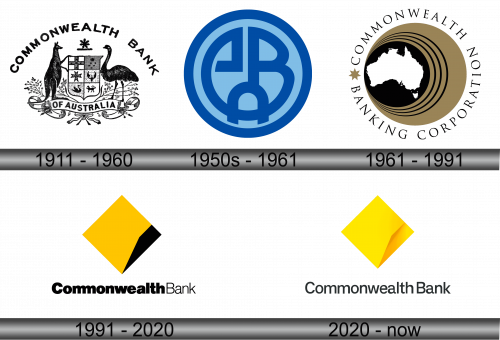Commonwealth Bank Logo
Commonwealth Bank, Australia’s largest bank, specializes in retail and commercial banking, with significant operations in wealth management and insurance. Its primary market is Australia, with expanding presences in Asia, the U.S., and the U.K. The bank is publicly traded on the Australian Securities Exchange, with diverse ownership by institutional and retail investors. A key player in the financial landscape, it is renowned for innovative solutions, like its mobile app, addressing modern financial needs. Its commitment to sustainability is evident in its eco-friendly initiatives and community programs, emphasizing its role as a socially responsible entity in today’s dynamic global economy.
Meaning and history
Commonwealth Bank of Australia, founded in 1911, has a rich history that mirrors Australia’s economic development. Initially government-owned, it was fully privatized by 1996, reflecting a significant transformation in its operational scope and market approach.
The bank initially focused on savings and general banking services, but with time, it diversified into a plethora of services like retail and commercial banking, insurance, and wealth management. This diversification was a strategic move to bolster its market presence and financial stability.
The bank’s expansion wasn’t confined to Australia. Over the years, it has stretched its operations internationally, making notable inroads in Asia, the United States, and the United Kingdom. This global expansion was a strategic maneuver to tap into emerging markets and spread its risk.
A pivotal moment in its history was the acquisition of Colonial Limited in 2000, marking its foray into wealth management. This acquisition was a testament to the bank’s strategic foresight, as it allowed them to cater to the growing demand for financial advisory services.
Throughout its journey, Commonwealth Bank has been at the forefront of technological innovation. It was among the first to introduce online banking in Australia in 1997 and continues to lead the way with its award-winning mobile app.
Today, the bank stands tall as a public entity, with its shares traded on the Australian Securities Exchange. Its diverse ownership, ranging from institutional to retail investors, is a testament to its broad appeal and robust financial health.
As we look at Commonwealth Bank’s history, it’s evident that the strategic decisions made at each step, from diversification to technological innovation, have been instrumental in shaping it into the financial powerhouse it is today. Its commitment to sustainability, evident in its eco-friendly initiatives, further cements its role as a socially responsible entity in today’s global economy.
1911 – 1960
The CBA, established by the Labor government, initially featured a logo that echoed the Australian coat of arms. At its heart was a heraldic shield split into six parts, each holding the emblem of one of Australia’s six states: a cross, the Southern Cross crowned, an eight-pointed Maltese cross, a shrike, a swan, and a lion. Above this shield sat the Commonwealth Star, its six rays symbolizing the states, with the seventh ray representing the country’s territories.
This shield was flanked by a kangaroo and an emu, iconic symbols of Australia’s unique wildlife. The base was adorned with blooming acacia branches and a ribbon marked “OF AUSTRALIA.” “COMMONWEALTH BANK” arched over the top. This logo remained unchanged until 1960, with a single revision in 1926.
Over the course of nearly half a century, the logo stood as a testament to the bank’s roots and its commitment to serving the diverse needs of the Australian populace. It encapsulated the bank’s foundational values and symbolized its integral role in the nation’s economic fabric. The intricate detailing and symbolism in the logo reflected the bank’s dedication to upholding Australia’s rich heritage while carving a path of financial stability and prosperity for its customers.
1950s – 1961
In the 1950s, the Commonwealth Bank of Australia (CommBank) introduced a circular blue CBA badge. While this never became the bank’s primary emblem, it was informally adopted on specific bank facades and various stationery items. The predominant symbol remained the coat of arms, proudly featuring the shield.
This shift in logo design marked a subtle yet significant evolution in the bank’s branding strategy, reflecting its attempt to modernize and stay relevant in an ever-changing financial landscape. The introduction of the CBA badge represented the bank’s willingness to embrace new ideas and adapt its image to resonate with a broader audience while still holding on to its historical coat of arms, a symbol of its rich heritage and steadfast values. This blend of the old and the new encapsulated the bank’s commitment to honoring its past while paving the way for future success and innovation.
1961 – 1991
In 1960, the institution underwent a significant structural transformation, splitting into two distinct entities. This marked the inception of the Commonwealth Banking Corporation, a collective of savings and merchant banks. In conjunction with this change, a new logo was introduced, featuring a white contour map of Australia set within a black circle. This circle was then encased within three divergent rings on the right, each representing the corporation’s three divisions: CDB, CTB, and CSB.
A large, dark gold circle encapsulated all these elements, its color evoking connotations of affluence and prosperity. Encircling the logo, the name Commonwealth Banking Corporation was inscribed, with the first two words separated by a heptagonal star. This star, mirroring the symbolism in Australia’s coat of arms, represented the unity of the states and territories that form the nation. This new logo was emblematic of the corporation’s forward-thinking approach and its continued commitment to representing Australia’s diverse financial landscape.
1991 – 2020
In 1991, CommBank embarked on a journey of privatization. This pivotal moment was preceded by its incorporation with the State Bank of Victoria, culminating in the formation of a united banking group. Recognizing a need for revitalization, especially given the outdated image perceived by customers since 1987, the new proprietors initiated a radical transformation of CBA’s style. This metamorphosis birthed the Diamond logo, a testament to the meticulous craftsmanship of designer Ken Cato.
In this design, the dark yellow segment echoed the Southern Cross constellation, while a diminutive black corner lent the figure its diamond silhouette. A snug inscription nestled at the base, where the words “Commonwealth” and “Bank” seamlessly merged, distinguished only by the bolder font of the former. Notably, the “mm” in “Commonwealth” shared a horizontal line, subtly alluding to unity – a nod to the communal essence with which the bank was synonymous. This comprehensive redesign not only modernized the bank’s image but also encapsulated its essence and commitment to the community it serves.
2020 – Today
In the year 2020, the Commonwealth Bank of Australia (CBA) underwent its fifth logo transformation. The groundwork for this significant rebranding exercise had been meticulously laid out in the preceding years, with the bank’s leadership meticulously biding their time, awaiting the opportune moment to unveil their new identity. Finally, 2020 was chosen as the perfect time for this significant shift. To facilitate this transformation, CBA enlisted the expertise of M&C Saatchi and Re.
The challenge was to retain the iconic diamond, yet infuse it with a more optimistic and modern vibe. The creative minds at the agencies rose to the occasion by eliminating the black corner and embracing a vibrant yellow color palette, thus injecting a dose of vibrancy and energy into the otherwise static emblem. This move was complemented by a gradient effect, which added a dynamic touch to the logo. Additionally, the bank’s name underwent a subtle change, with “Commonwealth” and “Bank” now appearing as separate entities, albeit unified through the use of a singular font. This careful blend of traditional and contemporary elements captures the essence of CBA’s rich heritage while simultaneously projecting a forward-looking, progressive brand identity.
















